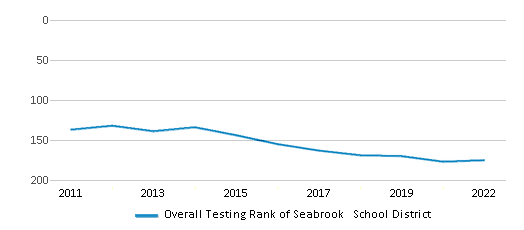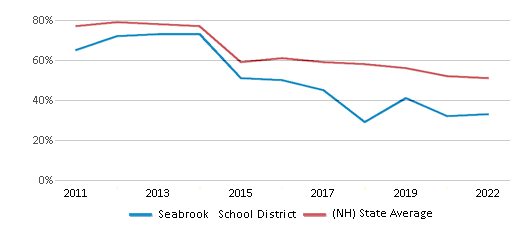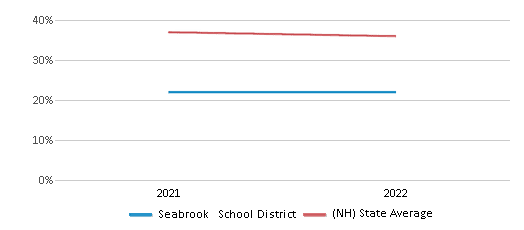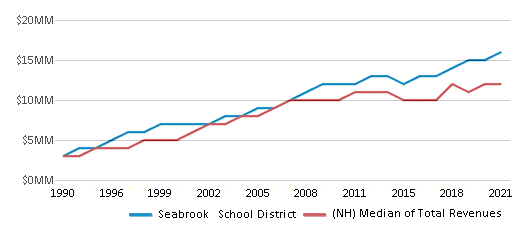Top Rankings
Seabrook School District ranks among the top 20% of public school district in New Hampshire for:
Category
Attribute
Diversity
Most diverse schools (Top 1%)
For the 2025 school year, there are 2 public elementary schools serving 645 students in Seabrook School District. This district's average elementary testing ranking is 1/10, which is in the bottom 50% of public elementary schools in New Hampshire.
Public Elementary Schools in Seabrook School District have an average math proficiency score of 23% (versus the New Hampshire public elementary school average of 41%), and reading proficiency score of 33% (versus the 49% statewide average).
Minority enrollment is 21% of the student body (majority Hispanic), which is more than the New Hampshire public elementary school average of 18% (majority Hispanic).
Overview
This School District
This State (NH)
# Schools
2 Schools
368 Schools
# Students
645 Students
107,278 Students
# Teachers
58 Teachers
9,553 Teachers
Student : Teacher Ratio
11:1
11:1
District Rank
Seabrook School District, which is ranked within the bottom 50% of all 189 school districts in New Hampshire (based off of combined math and reading proficiency testing data) for the 2021-2022 school year.
Overall District Rank
#175 out of 189 school districts
(Bottom 50%)
(Bottom 50%)

Math Test Scores (% Proficient)
23%
40%

Reading/Language Arts Test Scores (% Proficient)
33%
51%

Science Test Scores (% Proficient)
20-24%
36%

Students by Ethnicity:
Diversity Score
0.36
0.32
# American Indian Students
n/a
182 Students
% American Indian Students
n/a
n/a
# Asian Students
8 Students
3,091 Students
% Asian Students
1%
3%
# Hispanic Students
52 Students
8,138 Students
% Hispanic Students
8%
8%
# Black Students
10 Students
2,232 Students
% Black Students
2%
2%
# White Students
511 Students
87,889 Students
% White Students
79%
82%
# Hawaiian Students
1 Student
74 Students
% Hawaiian Students
n/a
n/a
# Two or more races Students
63 Students
5,673 Students
% of Two or more races Students
10%
5%
Students by Grade:
# Students in PK Grade:
38
3,041
# Students in K Grade:
59
10,416
# Students in 1st Grade:
60
11,733
# Students in 2nd Grade:
55
12,179
# Students in 3rd Grade:
61
12,078
# Students in 4th Grade:
71
12,182
# Students in 5th Grade:
74
12,522
# Students in 6th Grade:
76
11,957
# Students in 7th Grade:
72
10,676
# Students in 8th Grade:
79
10,354
# Students in 9th Grade:
-
36
# Students in 10th Grade:
-
41
# Students in 11th Grade:
-
28
# Students in 12th Grade:
-
35
# Ungraded Students:
-
-
District Revenue and Spending
The revenue/student of $25,043 is higher than the state median of $22,075. The school district revenue/student has stayed relatively flat over four school years.
The school district's spending/student of $24,084 is higher than the state median of $21,293. The school district spending/student has stayed relatively flat over four school years.
Total Revenue
$16 MM
$3,646 MM

Spending
$16 MM
$3,517 MM

Revenue / Student
$25,043
$22,075

Spending / Student
$24,084
$21,293

Best Seabrook School District Public Elementary Schools (2025)
School
(Math and Reading Proficiency)
(Math and Reading Proficiency)
Location
Grades
Students
Rank: #11.
Seabrook Elementary School
(Math: 35-39% | Reading: 30-34%)
Rank:
Rank:
3/
Bottom 50%10
256 Walton Rd.
Seabrook, NH 03874
(603) 474-2252
Seabrook, NH 03874
(603) 474-2252
Grades: PK-4
| 344 students
Rank: #22.
Seabrook Middle School
(Math: 16% | Reading: 33%)
Rank:
Rank:
1/
Bottom 50%10
256 Walton Rd.
Seabrook, NH 03874
(603) 474-9221
Seabrook, NH 03874
(603) 474-9221
Grades: 5-8
| 301 students
Recent Articles

Year-Round Or Traditional Schedule?
Which is more appropriate for your child? A year-round attendance schedule or traditional schedule? We look at the pros and cons.

Why You Should Encourage Your Child to Join a Sports Team
Participating in team sports has a great many benefits for children, there is no doubt. In this article you will learn what those benefits are.

White Students are Now the Minority in U.S. Public Schools
Increasing birth rates among immigrant families from Asia and Central and South America, combined with lower birth rates among white families, means that for the first time in history, public school students in the United States are majority-minority. This shift in demographics poses difficulties for schools as they work to accommodate children of varying language abilities and socio-economic backgrounds.





